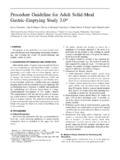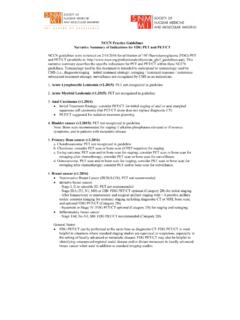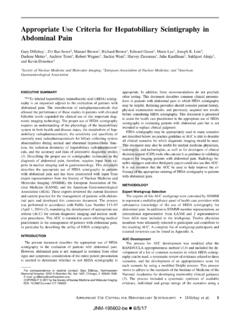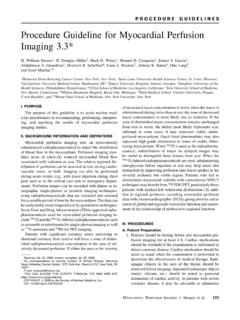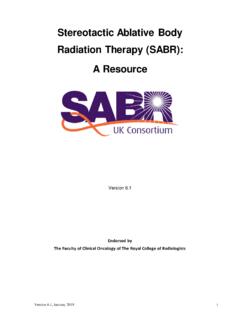Transcription of Nuclear Medicine Technologist Scope of Practice and ...
1 Nuclear Medicine Technologist Scope of Practice and Performance Standards Prepared by: Society of Nuclear Medicine and Molecular Imaging Technologist Section Approved: June 2017. 1 Overview of Document 2. 3 This document includes the Scope of Practice and the Performance Standards for health care 4 professionals that, for the purposes of this document, will be referred to as a Nuclear 5 Medicine Technologist . 6. 7 The spectrum of responsibilities for a Nuclear Medicine Technologist varies widely across 8 the United States. Practice components presented in this document include what is taught in 9 Nuclear Medicine programs, tested by accrediting organizations, and practiced in the field. 10 This document provides a basis for establishing the areas of knowledge and performance for 11 the Nuclear Medicine Technologist . 12. 13 The Nuclear Medicine Technologist MUST BE IN COMPLIANCE WITH ALL FEDERAL, 14 STATE, AND INSTITUIONAL GUIDELINES including proper documentation of initial 15 and continued competency in those practices and activities.
2 16. 17 Continuing education is a necessary component in maintaining the skills required to perform 18 all duties and tasks of the Nuclear Medicine Technologist in this ever-evolving field. 19. 20 Limitation of Scope and Disclaimer 21. 22 This document is intended to set forth the standards in important areas of the Nuclear 23 Medicine Technologist 's responsibilities. It may not cover all areas which may present 24 themselves in actual Practice . These standards do not supersede the judgment of the 25 individual Nuclear Medicine Technologist and other healthcare professionals serving the 26 patient in light of all of the facts of the individual case. THE SOCIETY OF Nuclear . 27 Medicine AND MOLECULAR IMAGING AND THE SOCIETY OF Nuclear . 28 Medicine AND MOLECULAR IMAGING Technologist SECTION DISCLAIM. 29 ALL LIABILITY ARISING FROM USE OF THESE DOCUMENTS. 30. 31 Overview 32.
3 33 Nuclear Medicine is a medical technology that utilizes sealed and unsealed radioactive 34 materials for diagnostic, treatment, and research purposes. Nuclear Medicine instrumentation 35 may be combined with, computed tomography (CT), magnetic resonance imaging (MRI), or 36 other modalities to produce three-dimensional images with or without adjunctive and other 37 imaging medications to enhance the evaluation of physiological processes at a molecular 38 level. 39. 40 Technologist Qualified to Perform Nuclear Medicine Procedures 41. 42 Under the supervision of an authorized user, the Nuclear Medicine Technologist is 43 responsible for the safe use of ionizing and nonionizing radiation and molecular imaging for 44 diagnostic, therapeutic, and research purposes. The Technologist will review the patient's 45 medical history to understand the patient's illness, medical issue, and pending diagnostic or 46 treatment procedure; instruct the patient before, during, and following the procedure.
4 Nuclear Medicine Technologist Scope OF Practice AND. PERFORMANCE STANDARDS June 2017. 47 evaluate the satisfactory preparation of the patient before beginning a procedure; and 48 recognize emergency patient conditions and initiate lifesaving first aid when appropriate. 49. 50 Administrative functions may include supervising other technologists, students, and other 51 personnel; participating in procuring supplies and equipment; documenting laboratory 52 operations; participating in radiation safety protocols and taking an active role in radiation 53 reduction programs; participating in departmental inspections conducted by various licensing, 54 regulatory, and accrediting agencies; participating in departmental quality assurance or 55 quality improvement projects; and participating in scheduling patient procedures. 56. 57 A certified Nuclear Medicine Technologist is an individual who is registered or certified by the 58 Nuclear Medicine Technology Certification Board (NMTCB), the American Registry of 59 Radiologic Technologists (ARRT), Canadian Association of Medical radiation 60 Technologists (CAMRT), and/or any other certification board accepted by your state or 61 institution.
5 A certified Nuclear Medicine Technologist is qualified to perform general Nuclear 62 Medicine procedures, Nuclear Medicine therapy, Nuclear cardiology procedures, Nuclear 63 breast procedures, positron emission tomography (PET) procedures, and CT attenuation 64 correction and localization at entry level. An advanced certification in CT through the 65 NMTCB, ARRT, CAMRT, and/or any other certification board accepted by your state or 66 institution qualifies a certified Nuclear Medicine Technologist to perform diagnostic CT. A. 67 certified Nuclear Medicine Technologist is qualified to perform PET/MR with training and 68 education in MR. 69. 70 Education 71 Nuclear Medicine Technologists may complete a one- or two- year certificate program, a 72 two-year associate's degree, bachelor's degree or Master's Degree. Didactic courses include 73 but are not limited to the physical sciences, biological effects of radiation exposure, radiation 74 protection, radiation procedures, CT anatomy and physics, the use of radiopharmaceuticals, 75 adjunctive medications, imaging medication, imaging techniques, and computer applications.
6 76 A structured clinical education component provides experience in the clinical environment. 77 Clinical education is designed to meet the requirements of the certification exams. Graduates 78 of accredited programs are eligible to sit for certification examinations offered by the 79 NMTCB, ARRT, and/or any other certification board accepted by your state or institution. 80 The Joint Review Committee on Education Programs in Nuclear Medicine Technology 81 accredits training programs in Nuclear Medicine technology. 82. 83 Licensure 84 Requirements for licensure of all imaging technologists vary from state to state, so it is 85 important that technologists check the requirements of the state in which they plan to work. 86. 87 Certification 88 Certification is available from the NMTCB, ARRT, and/or any other certification board 89 accepted by your state or institution 90.
7 91 Continuing Education 92 In addition to the general certification requirements, certified technologists also must 3. Nuclear Medicine Technologist Scope OF Practice AND. PERFORMANCE STANDARDS June 2017. 93 complete a certain number of continuing education hours to maintain certification. 94 Continuing education is required because of the frequent technological and 95 radiopharmaceutical innovations. 96. 97. 98 Code of Ethics 99. 100 Technologists qualified to perform Nuclear Medicine procedures are members of the health 101 care profession and must strive as individuals and as a group to maintain the highest ethical 102 standards by adhering to the Nuclear Medicine Technologist Code of Ethics approved by the 103 Society of Nuclear Medicine and Molecular Imaging Technologist Section (SNMMITS). 104. 105 The principles of the Nuclear Medicine Technologist Code of Ethics as listed below are not 106 laws, but standards of conduct to be used as ethical guidelines by Nuclear Medicine 107 technologists.
8 108. 109 Principle 1. 110 The Nuclear Medicine Technologist will provide services with compassion and respect for 111 the dignity of the individual and with the intent to provide the highest quality of patient 112 care. 113. 114 Principle 2. 115 The Nuclear Medicine Technologist will provide care without discrimination regarding the 116 nature of the illness or disease, gender, race, religion, sexual preference, or 117 socioeconomic status of the patient. 118. 119 Principle 3. 120 The Nuclear Medicine Technologist will maintain strict patient confidentiality in 121 accordance with state and federal regulations. 122. 123 Principle 4. 124 The Nuclear Medicine Technologist will comply with the laws, regulations, and policies 125 governing the Practice of Nuclear Medicine . 126. 127 Principle 5. 128 The Nuclear Medicine Technologist will continually strive to improve his or her 129 knowledge and technical skills.
9 130. 131 Principle 6. 132 The Nuclear Medicine Technologist will not engage in fraud, deception, or criminal 133 activities. 134. 135 Principle 7. 136 The Nuclear Medicine Technologist will be an advocate for his or her profession. 137. 138 Definitions 4. Nuclear Medicine Technologist Scope OF Practice AND. PERFORMANCE STANDARDS June 2017. 139. 140 Adjunctive Medication: Adjunctive medications are defined as those medications used 141 to evoke a specific physiological or biochemical response used in conjunction with 142 diagnostic imaging or therapeutic procedures. 143. 144 ALARA: ALARA is an acronym for "as low as (is) reasonably achievable," which 145 means making every reasonable effort to maintain exposures to ionizing radiation as far 146 below the dose limits as practical. The NRC definition under 10 CFR Part of 147 ALARA can be found here: 148 ref/ 149. 150 Authorized User: A physician licensed to permit the medical use of byproduct 151 material.
10 The NRC definition under 10 CFR Part of an Authorized User can be 152 found here: /part - .html 153. 154 Computed Tomography: A medical imaging technology that uses a computer to 155 acquire a volume of x-ray based images, generally reconstructed as two-dimensional 156 (2D) or three- dimensional (3D) pictures of inside the body. 157. 158 Diagnostic Imaging: Diagnostic imaging uses technologies such as x-ray, CT, MR, 159 ultrasound, general Nuclear Medicine , PET, and single-photon emission computed 160 tomography (SPECT) to provide physicians with a way to look inside the body without 161 surgery. 162. 163 Diagnostic Nuclear Medicine : The use of radioactive materials (called 164 radiopharmaceuticals or radiotracers) to evaluate molecular, metabolic, physiologic, 165 anatomic, and pathologic conditions of the body for the purposes of diagnosis and 166 research. 167. 168 Hybrid Imaging: The combination of imaging technologies that allows information 169 from different modalities to be presented as a single set of images.


